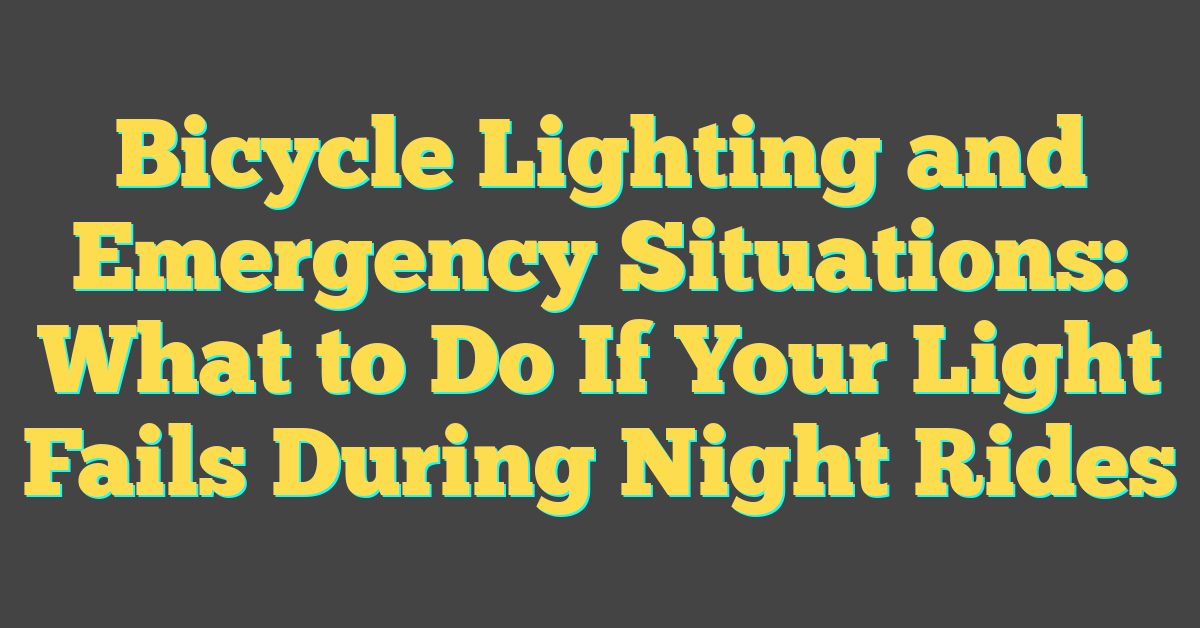There’s nothing quite like the freedom of riding a bike at night—the cool breeze, the quiet streets, and the glow of your lights cutting through the darkness. But what happens when that glow suddenly disappears? A failed bike light can turn a peaceful ride into a stressful situation in seconds.

I’ve been there, fumbling in the dark, trying to figure out my next move. It’s not just inconvenient; it can be downright dangerous. That’s why it’s so important to know how to handle these moments and stay safe when your light fails unexpectedly. Let’s talk about how to keep your ride smooth, even when the unexpected happens.
Importance Of Bicycle Lighting
Effective bicycle lighting is critical for ensuring visibility and safety, especially during low-light conditions or at night. Proper lights allow you to see obstacles, road conditions, and potential hazards clearly. They also make it easier for motorists, pedestrians, and other cyclists to notice your presence, reducing the risk of accidents.
Front lights are essential for illuminating the path ahead. For example, a bright white LED light helps you identify potholes, debris, or uneven surfaces. Rear lights further enhance safety by signaling your position to vehicles approaching from behind. A red blinking rear light, for instance, increases visibility significantly in traffic.
Local laws often mandate the use of bike lights after dark. In many areas, failing to equip proper front and rear lights can result in fines. Beyond legality, reliable lighting demonstrates responsibility and proactive care for personal safety.
Weather conditions like rain or fog often reduce overall visibility on the road. High-quality, water-resistant lights improve your chance of being seen in such situations. For instance, a rechargeable light with a wide beam angle ensures visibility even in adverse weather.
Lastly, I believe investing in good bike lighting is part of enjoying the ride. Durable, multi-mode lights enhance my night rides and give me peace of mind, knowing I’m well-prepared for the journey ahead.
Common Causes Of Bicycle Light Failures
Bicycle light failures can happen unexpectedly, creating difficult situations for nighttime cyclists. Understanding the primary causes helps address issues effectively and prevents future problems.
Battery Issues
Battery problems are one of the most frequent failures in bike lights. Rechargeable batteries often lose capacity over time, leading to shorter runtimes. For example, I’ve noticed lithium-ion batteries becoming unreliable after several hundred charge cycles. Alkaline batteries, on the other hand, can drain quickly in cold weather, leaving riders unprepared during winter rides. Forgetting to charge the light or carry spare batteries compounds the issue, making regular battery checks essential.
Physical Damage
Physical damage compromises a light’s functionality. Dropping your bike, collisions, or even over-tightening the mount can crack the housing or dislodge components. I’ve seen cases where water seeped into damaged lights, causing corrosion in the circuitry. Off-road cycling increases the chances of vibration-related issues, such as loosened connections. Protecting lights with sturdy housings and regularly inspecting mounts prevents such problems from escalating.
Electrical Malfunctions
Electrical failures often stem from faulty wiring, poor circuit design, or worn components. In my experience, low-quality lights are more prone to internal shorts or loose solder joints, especially after prolonged use. Inconsistent light output or flickering can indicate underlying electrical problems. Exposure to rain further accelerates these failures if the light lacks proper waterproofing. Investing in weather-sealed, well-designed lighting minimizes risks.
Preparing For Emergencies
Having a plan for unexpected lighting failures can turn a stressful situation into a manageable one. I always ensure I’m prepared for any emergencies while biking at night.
Carrying Backup Lights
I always bring a secondary set of lights with me during nighttime rides. Compact, battery-powered clip-on lights work well for this purpose, especially models with long runtime. Rechargeable USB lights are convenient, but I prefer ones that use disposable batteries as backups since they can be replaced quickly. For example, I carry a small LED headlamp or a lightweight rear light to ensure visibility until I can resolve the main light issue.
Using Reflective Gear
In addition to lights, reflective gear ensures I remain visible in case of a light failure. Reflective vests, ankle bands, or adhesive strips on my bike frame significantly enhance visibility. Reflectors integrated into my pedals and wheels also catch a motorist’s headlights effectively. During emergencies, these passive visibility options complement my backup lighting.
Checking Your Lights Regularly
Routine checks extend the reliability of lighting systems. I inspect battery levels before every ride, cleaning the contacts if needed, and ensuring they’re charged or fresh. I test all lighting modes and look for loose connections or damage to the housing. A quick visual assessment of weatherproof seals ensures they’ll perform in rainy conditions too. Regular checks reduce the chance of failure, helping me bike with confidence at night.
Immediate Actions If Your Light Fails
« How to Set Up Lights for Cargo Bikes and Child Carriers: Safety Tips You Can’t Miss
The Role of Lighting in Bicycle Commuter Culture: Safety, Style, and Cutting-Edge Tech Trends »
A sudden light failure while riding can feel alarming, especially at night. Staying calm and taking immediate steps ensures your safety and visibility until the situation is resolved.
Staying Visible
Maintaining visibility is my top priority when a light fails. I always rely on my backup lights for quick activation. Compact clip-on LED lights or lightweight headlamps work well as emergency replacements. If those aren’t available, adding reflective gear can significantly improve visibility. Reflective vests, ankle bands, or even using your bike’s built-in reflectors ensure others can see you.
Active signaling also helps. If you’re in an area with traffic, waving your phone’s flashlight or turning on its screen brightens your position temporarily. I suggest keeping a small USB-powered light in your repair kit; it’s versatile and fits into most setups without hassle.
Seeking A Safe Spot
Finding a safe spot to address the issue is critical. I quickly move to a well-lit area, such as a sidewalk or parking lot, away from vehicle lanes. If well-lit areas are distant, pulling over to the edge of a quiet road or trail is the next-best option.
Assessing the problem comes next. Checking for loose connections, battery failure, or physical damage can help determine if the light is repairable on the spot or if backup options will carry you the rest of the way. When I can’t fix the issue immediately, I minimize the distance to my destination while sticking to safe, low-traffic routes.
Long-Term Solutions For Better Lighting
Effective lighting systems can transform nighttime biking into a safer, more enjoyable experience. Ensuring your bike lights are both reliable and durable requires smart investments and consistent care.
Investing In Quality Lighting Systems
Choosing high-performance lighting makes a noticeable difference during night rides. I always recommend LED bike lights, as they offer superior brightness with lower power consumption. Look for models with a minimum of 300 lumens for urban riding or 800 lumens for trails. High-capacity, rechargeable lithium-ion batteries are ideal due to their extended runtime and resilience in varied temperatures.
Opt for lights with durable aluminum housings instead of plastic ones. These resist impacts better during falls or accidents. Water resistance, rated at least IPX4, is critical for riding in rain or humid conditions. Some top brands I trust include Cateye, NiteRider, and Lezyne. Spending a little more upfront on well-designed lights prevents frequent replacements and ensures consistent performance.
Tips For Maintenance And Durability
Regular care maximizes the lifespan of your lighting systems. I clean my lights weekly with a soft cloth and check battery contacts for corrosion. After every rain ride, I dry any moisture around the seals to prevent damage. It’s also good practice to recharge batteries after every use, even if they aren’t fully drained.
I often inspect mounting brackets to ensure they’re secure. Loose mounts increase vibration, which can damage internal components over time. Applying a thin layer of silicone grease around weatherproof seals keeps them effective. When storing lights for extended periods, I remove batteries to avoid leakage.
By combining quality equipment with proper maintenance, I’ve enjoyed years of trouble-free nighttime riding. Investing time and effort pays off when your bike lights remain bright and dependable whenever you need them.
Conclusion
Riding at night can be an incredible experience, but it’s not without its challenges. Preparing for the unexpected, like a light failure, ensures you can stay safe and keep your ride enjoyable. With the right gear, regular maintenance, and a plan for emergencies, you’ll be ready to handle anything that comes your way.
Investing in quality lighting and taking proactive steps to protect it makes a huge difference. Pair that with backup options and reflective gear, and you’ll have peace of mind every time you head out after dark. Night rides should be about freedom, not stress, so stay prepared and enjoy the journey!




